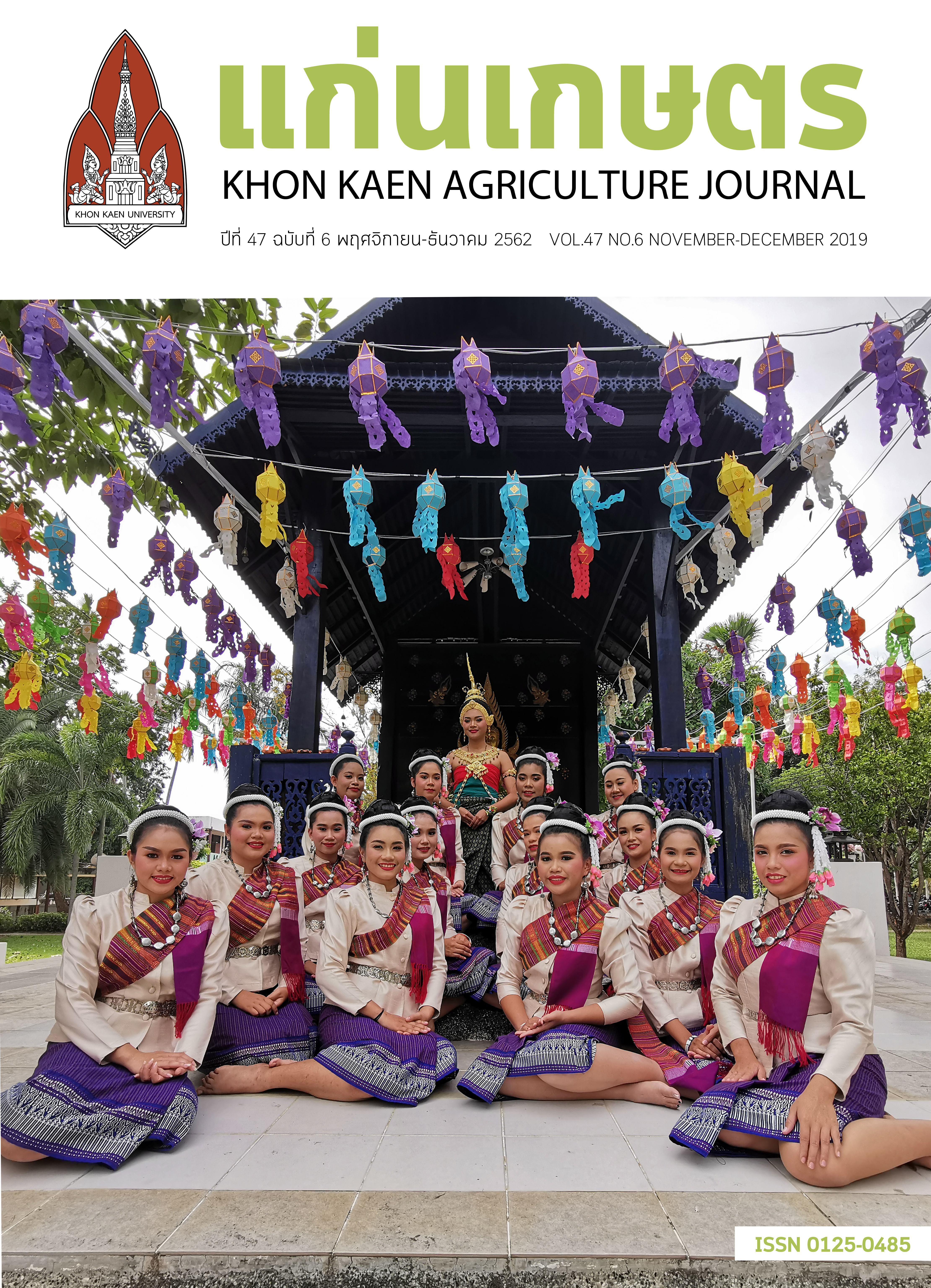ผลของความเข้มแสงต่อการเจริญเติบโตและผลผลิตของผักกาดหอมในระบบแพลนท์แฟคทอรี่
Main Article Content
บทคัดย่อ
การศึกษาความเข้มแสงของหลอดไฟชนิด Light Emitting Diodes (LEDs หรือ แอลอีดี) ที่มีผลต่อการเจริญเติบโตและผลผลิตของผักกาดหอมในระบบแพลนท์แฟคทอรี่ เปรียบเทียบกับการปลูกกลางแจ้ง วางแผนการทดลองแบบ 5x2 Factorial in CRD ปัจจัยที่ 1 คือปลูกภายใต้ความเข้มแสง 5 ระดับ ได้แก่ 1) แอลอีดีสีขาวความเข้มแสง 120 μmolm-2s-1 2) แอลอีดีสีขาวความเข้มแสง 140 μmolm-2s-1 3) แอลอีดีสีขาว แดง น้ำเงิน ความเข้มแสง 110 μmolm-2s-1 4) แอลอีดีสีขาว แดง น้ำเงิน ความเข้มแสง 120 μmolm-2s-1 และ 5) การปลูกกลางแจ้งภายใต้แสงอาทิตย์ ความเข้มแสง 1,200 μmolm-2s-1 และปัจจัยที่ 2 คือพันธุ์ผักกาดหอม ได้แก่ เรดโอ๊ค และกรีนโอ๊ค ปลูกในระบบไฮโดรพอนิกส์น้ำลึกแบบแนวตั้ง เปิดไฟนาน 16 ชั่วโมงต่อวัน ควบคุมอุณหภูมิ 24 องศาเซลเซียส เก็บเกี่ยวผลผลิตที่อายุ 45 วันหลังเพาะเมล็ด พบว่าผักกาดหอมที่ปลูกภายใต้ระบบแพลนท์แฟคทอรี่ ให้ค่าเฉลี่ยความกว้างทรงพุ่ม จำนวนใบ และพื้นที่ใบของผักกาดหอมสูงที่สุดแตกต่างทางสถิติเมื่อเปรียบเทียบกับการปลูกกลางแจ้ง แต่หลังจากเก็บเกี่ยว พบว่าการปลูกกลางแจ้งให้น้ำหนักสด น้ำหนักแห้งและปริมาณคลอโรฟิลล์สูงสุดแตกต่างกันอย่างมีนัยสำคัญทางสถิติ และผักกาดหอมทั้ง 2 พันธุ์ มีการเจริญเติบโตทางลำต้นที่ไม่แตกต่างกัน แต่พบว่าผักกาดหอมพันธุ์กรีนโอ๊คการตอบสนองมากที่สุด โดยให้ค่าเฉลี่ยพื้นที่ใบ น้ำหนักสด และน้ำหนักแห้งสูงที่สุด แต่มีปริมาณคลอโรฟิลล์น้อยกว่าผักกาดหอมพันธุ์เรดโอ๊ค
Article Details
เอกสารอ้างอิง
พิชญ์สินี เพชรไทย และ ธรรมศักดิ์ ทองเกตุ. 2560. ผลของความเข้มแสงและระยะเวลารับแสงต่อการเจริญเติบโตและคุณภาพของผักกาดหอม. ว.พืชศาสตร์สงขลานครินทร์ 4 : 54-59.
Bourget, C.M., 2008. An introduction to light-emitting diodes. HortSci 43.1944–1946.
Brougham, R.K. 1960. The relationship between the critical leaf area, total chlorophyll content, and maximum growth-rate of some pasture and crop plants. Ann. Bot. (Lond.) 24: 463–474.
Food and Agriculture. Organization of the United Nations (FAO). “Global food security index 2012”. Economist Intelligence Unit, p 10. 2012.
Fujita, A., Soma, N., Goto-Yamamoto, N., Mizuno, A., Kiso, K. and Hashizume, K. 2007. Effect of shading on proanthocyanidin biosynthesis in the grape berry. Journal of the Japanese Society for HortSci.76: 112-119.
Jeong Hwa Kang, Sugumaran Krishna Kumar, Sarah Louise Sua Atulba, Byoung Ryong Jeong, and Seung Jae Hwang. 2013. Light intensity and photoperiod influence the growth and development of hydroponically grown leaf lettuce in a closed-type plant factory system Hort. Environ. Biotechnol. 54: 501-509.
Kim H-H, Goins G, Wheeler R, and Sager J. 2004. Green light supplementation for enhanced lettuce growth under red and blue light-emitting diodes, HortSci. 39: 1617-1622.
Kozai, T., G. Niu and M. Takagaki. 2016. Plant Factory: An Indoor Vertical Farming System for Efficient Quality Food Production. Academic Press., California, U.S.A.
Kuan-Hung Lina, Meng-Yuan Huangb,, Wen-Dar Huangc, Ming-Huang Hsuc, Zhi-Wei Yang, Chi-Ming Yang. 2013. Effects of red, blue, and white light-emitting diodes on the growth, development, and edible quality of hydroponically grown lettuce (Lactuca sativa L. var. capitata). HortSci 150: 86-91.
Massa, G.D., Kim, H.H., Wheeler, R.M., Mitchell, C.A., 2008. Plant productivity inresponse to LED lighting. HortSci 43: 1951–1956.
Morrow, R.C., 2008. LED lighting in horticulture. HortSci 43: 1947–1950.


